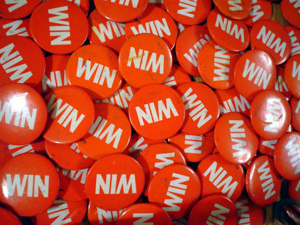 (NOTE: Check out my other Nim posts by clicking here.)
(NOTE: Check out my other Nim posts by clicking here.)
Looking around the web, I've discovered many new things related to Nim, a favorite game here at Grey Matters.
Instead of discussing a new variation of Nim, this post goes back and takes a closer look at some versions of Nim that have been discussed in previous posts.
Futility Closet just posted a puzzle called Last Cent, which is simply single-pile Nim played with 15 pennies and moves limited to taking 1, 2, or 3 pennies. If your Nim skills are rusty, try and work out the best strategy for this before moving on.
Moving on to multi-pile Nim, there's an attractive new table-top version of Nim now available, called Abacan. Below is a video review of Abacan, so you can get a better idea of how it looks and works.
It's described in the video as a game where the last player to make a move loses, but readers of Grey Matters know that you could change that rule to the last player to make a move being the winner, and only a minor change in strategy would be required.
With information from my posts on multi-pile Nim, you could work out the strategy for yourself, or you could just take the direct step of using the multi-pile Nim Strategy Calculator for a 5-pile game of piles consisting of 1, 3, 5, 7, and 9 objects.
Back in the March 1962 issue of Scientific American, Martin Gardner wrote about a game called Hexapawn, and how anyone could build a simple computer out of matchboxes and a few tokens that could learn how to win the game on its own! The article was reprinted in his book The Unexpected Hanging and Other Mathematical Diversions, and later in chapter 35 of The Colossal Book of Mathematics.
In that chapter, Martin Gardner briefly mentions that such a computer could also be built to play Nim, but doesn't give much in the way to details. Over at Tony's Math Blog, Tony discusses a Nim matchbox learning computer in more detail, if this strikes you as a fun an interesting project. He called his set “A Nim's Game Experience Learning Automaton”, or A.N.G.E.L.A., for short.
Besides Martin Gardner's classic writings on this game, there are also some excellent papers and lectures about Nim available on the web. Paul Gafni has a multi-part video on YouTube, and here's the first video:
The complete series can be found at the following links:
Intro (This is the above video.)
Part 2
Part 3
Part 4
Part 5
David Metzler also has a lecture video series on Nim, and this one is a bit more technical, with computer graphics used to help explain the concepts. Here's the first video in David Metzler's Nim lecture series:
David Metzler's complete lecture can be found at these links:
Part 1 (This is the above video.)
Part 2
Part 3
Part 4
If you liked my Chocolate Nim post, there's an online paper focusing on approaches to different versions of Chocolate Nim at virtualsciencefair.org. Even if you don't understand it right away, trying out the included Java applets and practicing with real chocolate when possible will help you pick it up quickly.
If you remember my post on fractals from summer 2011, you might be startled to learn that Nim can be examined using fractals! It turns out that the humble Sierpinski triangle turns out to be an excellent tool for examining effective Nim plays, as explained in this PDF.
For even the most ardent Nim fan, there's plenty of material here to study for quite some time. If you've made your own interesting Nim discoveries, let me know about them in the comments!
0
Nim Updates
Published on Sunday, August 05, 2012 in books, Martin Gardner, math, nim, products, reviews, site features, videos
Related Posts
Post Details
Posted by Pi Guy on Aug 5, 2012
Labels:
books,
Martin Gardner,
math,
nim,
products,
reviews,
site features,
videos
Subscribe to:
Post Comments (Atom)




No Response to "Nim Updates"
Post a Comment